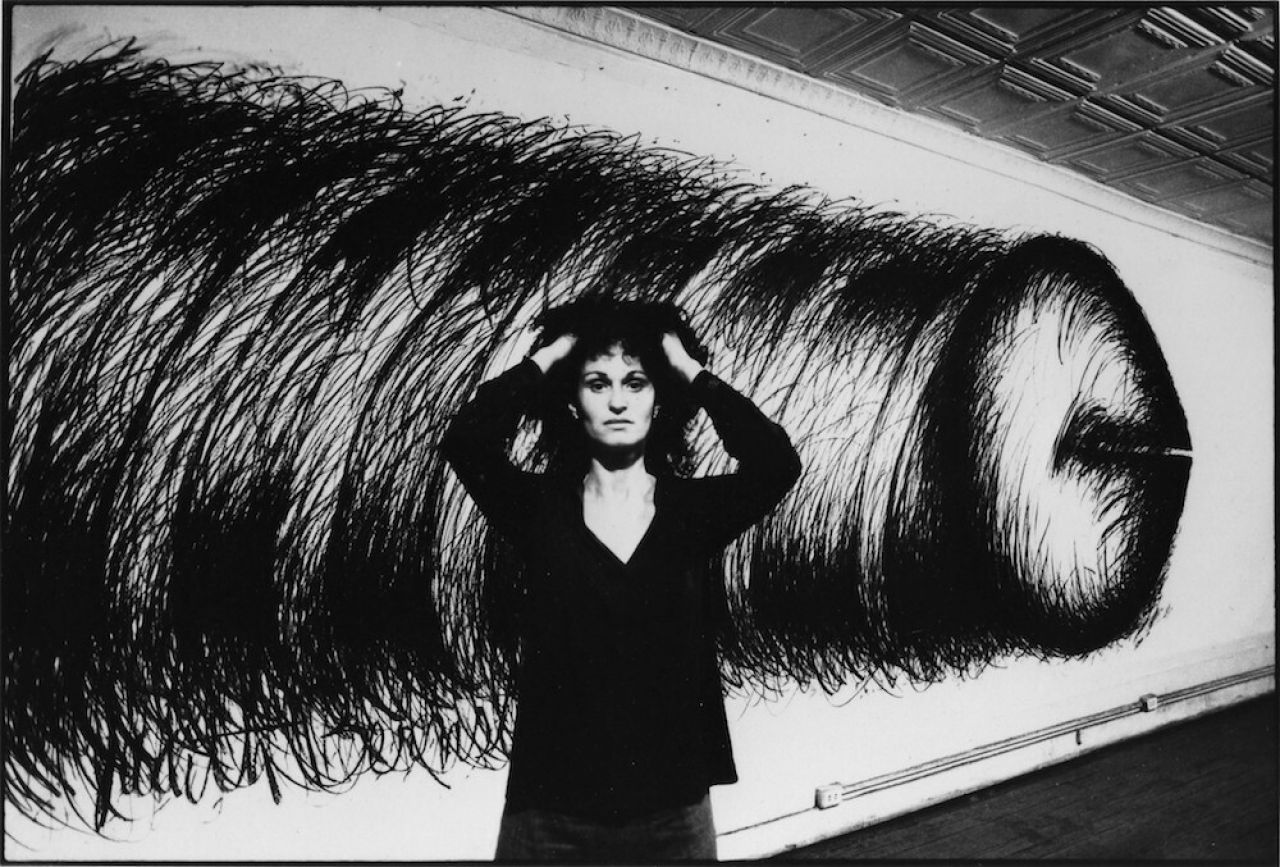October 01, 2019
Catching Up with Pioneering Feminist Artist Judith Bernstein (’63 B.S. Art Ed, ’64 M.Ed. Art Ed)

Interview by Professor Emerita Micaela Amateau Amato
Judith, in 2013, New York Times critic Ken Johnson wrote a review of your remarkable New Museum exhibition, referring to your work as "masterpieces of feminist protest" and "works of a woman tapping into her own potential for bravery, rage and aggression." This characterizes the work you have always made since the '60s, even as a student. How did you find your humor‚ coupled with outrage‚ always speaking truth to power in the first person, through a lens of social justice?
For the last 50+ years my art has been political and sexual, which is the core of what I am about. I'm naturally funny and humor translates easily into my work. The amalgamation of laughter with political and psychological commentary gives my art impact! My work has always been politically driven. Especially since I was a student at Yale, where I began sourcing imagery from graffiti in the men's bathroom to influence my Fuck Vietnam series. At that time, I thought there were so many dicks around, and the war was a total devastation. So my work in the early-mid '60s began with a combination of protest, feminism, sex and outrage.
Your career in the late '60s began with huge supportive response and notoriety that suddenly slipped into censorship. You arrived at inventive alternative vehicles for expressing your courageous energy and activism. Can you talk about these collaborations?
When I graduated from Yale there were very few opportunities for women. Out of frustration with no platform for women artists, a group of 20 artists in New York established AIR Gallery in 1972. This was the first gallery to be devoted to showing art made by women, where I had the gallery's first, as well as my first solo show, in 1973. Included in this AIR show was my drawing Horizontal, which was later censored in a very large group exhibition of women artists at the Philadelphia Civic Center. Horizontal is a massive charcoal drawing of a phallic screw, which was deemed pornographic by the conservative administrators. As a result of the censorship, other artists showed their support by wearing pins saying, "Where's Bernstein?"
My all-time hero is U.S. Representative Shirley Chisholm, the first African American woman in Congress, and, in 1972, the first to seek nomination for president of the United States. Who was your heroine/mentor as a young woman?
Shirley Chisholm was an EXTRAORDINARY PERSON! She has many famous quotes, including "I've been black and I've been a woman, and believe me, being a woman is worse." Addressing race: "'Liberty and justice for all' were beautiful words, but the ugly fact was that liberty and justice were only for white males."
I wish I had known her. I didn't really have mentors; I just did what I wanted. I mined my own thoughts and life. I've had support throughout my career from both female and male artists. Louise Bourgeois, Joyce Kozloff, Joan Semmel, Walter De Maria, Bill Copley (CPLY) and Paul McCarthy have provided much encouragement throughout my career.
How did AIR and the larger feminist community offer mutual support?
Graduating from Yale and coming to New York in the 1960s, I was like many ambitious women who were isolated from the art world. Galleries and museums were essentially closed off to us. We were shut out and had absolutely no platform to exhibit until AIR (Artist in Residence) was founded in 1972. I also found support through the Art Workers' Coalition (anti-war activism), Fight Censorship Group and Guerilla Girls.
Please talk about your early childhood making art and how the Penn State and Yale art programs prepared you for life as an artist‚ even a pioneering artist.
I exhibited natural artistic ability as a young person, winning many contests, and continued to make art until attending Penn State as an undergraduate. When I arrived at Penn State there were three men to every woman. Then when I went to Yale, it was an all-male school. When I graduated in 1967, that was the first year they allowed women as undergraduates. As a graduate student, there were only three women in my class, and all the rest were guys. It was a different time. Attending Penn State and Yale gave me the skills and tools that I needed to gain access to the system. I left Yale making mature work that continues to influence my practice today.
What's life like now with continuous exhibitions and ongoing dialogue?
FABULOUS! Many opportunities come to me now, and this allows me to do lots of things I would otherwise not have a chance to do. I make the work I want to make and I am able to show it!
For more information on Bernstein, visit https://www.judithbernstein.com.
Image: Judith Bernstein with Horizontal Plus #3, 1974. Photo: Frederick Canter
